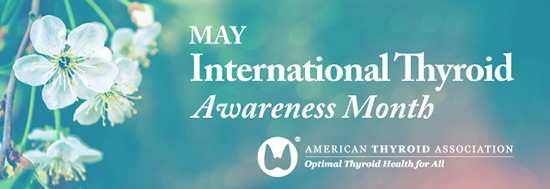
Clinical Thyroidology for the Public summarizes selected research studies discussed in the previous month’s issue of Clinical Thyroidology, an official publication of the American Thyroid Association. Editor-in-chief, Alan Farwell, MD, FACE
Available in pdf format for saving and printing and Web page format for viewing online
PDF Format for Saving and Printing
Clinical Thyroidology for the Public Volume 15 Issue 5 (PDF file, 2.62 MB)
TABLE OF CONTENTS – Web Format
HYPOTHYROIDISM
Hypothyroid patients described what brain fog feels like
One particular symptom that hypothyroid patients often report is brain fog. Interestingly, this symptom is also reported by patients with other chronic medical conditions. This study was done to better understand the symptoms associated with brain fog in patients with hypothyroidism, to find out how often it occurs and to determine what improves the symptoms commonly experienced in patients who suffer from brain fog.
Ettleson MD et al 2021 Brain fog in hypothyroidism: Understanding the patient’s perspective. Endocr Pract. Epub 2021 Dec 8. PMID: 34890786
THYROID CANCER
What are the risks and benefits of active surveillance vs immediate surgery in low risk thyroid cancer?
The management of low risk thyroid cancers has been changing and immediate surgery is no longer the only options. Active surveillance of low risk thyroid cancers has been shown to be a safe option. This study was done to provide information for further updates to these guidelines an answer two main questions: (1) what are the outcomes of performing surgery versus active surveillance of low risk thyroid cancer and (2) what are the results seen in studies that do not have a clear plan for close monitoring of these patients?
Chou R et al. 2022 Active surveillance versus thyroid surgery for differentiated thyroid cancer: A systematic review. Thyroid. Epub 2022 Jan 26. PMID: 35081743.
THYROID CANCER
Thyroid cancer location, in addition to size and growth, is important when selecting patients for active surveillance
In recent years, active surveillance has been proposed as an alternative management option for small, low risk thyroid cancers. However, the success of active surveillance depends on the selection of appropriate patients. This study aimed to better understand the significance of the location of the cancer within the thyroid gland and minimum cancer size when selecting patients for active surveillance
Newman SK et al 2022 Invasion of a recurrent laryngeal nerve from small well-differentiated papillary thyroid cancers: Patient selection implications for active surveillance. Thyroid 32:164–169. PMID: 34714169.
THYROID CANCER
Quality of life is similar between total thyroidectomy and lobectomy in thyroid cancer survivors at 1 year after surgery
The management of low risk thyroid cancers has been changing, as lobectomy has become more common. Indeed, there are studies suggesting that total thyroidectomy may be associated with higher cost, higher rate of complications and lower health related quality of life outcomes. This study was done to evaluate quality of life outcomes in large number of patients who were planning to have either a total thyroidectomy or lobectomy as
Chen W et al W 2021 Association of total thyroidectomy or thyroid lobectomy with the quality of life in patients with differentiated thyroid cancer with low to intermediate risk of recurrence. JAMA Surg. Epub 2021 Dec 22. PMID: 34935859.
HYPOTHYROIDISM
What is the likelihood of hypothyroidism after thyroid lobectomy in children?
Thyroid lobectomy is recognized to be preferred over removing the entire thyroid gland when possible. Although the majority of adult patients continue to have normal thyroid function after lobectomy, it is known that 15-30% of adults develop hypothyroidism and need to start thyroid hormone. This study was done to increase understanding of the risk of hypothyroidism in children after having a thyroid lobectomy.
Baran JA et al 2021 Clinical course of early postoperative hypothyroidism following thyroid lobectomy in pediatrics. Thyroid 31:1786–1793. PMID: 34714171.
THYROID CANCER
Patients treated with radioactive iodine for thyroid cancer in childhood or young adulthood may be at increased risk for developing a second cancer
Thyroid cancer is the most common endocrine cancer seen in children and young adults. While the use of radioactive iodine therapy in adults with thyroid cancer has markedly decreased, it is unclear if this should be the case for children, who have a higher risk of having the thyroid cancer coming back years later compared to adults. The aim of this study was to find out whether radioactive iodine therapy for thyroid cancer in childhood or young adulthood is associated with increased risk of developing a second cancer other than thyroid cancer.
Pasqual E et al 2022 Association between radioactive iodine treatment for pediatric and young adulthood differentiated thyroid cancer and risk of second primary malignancies. J Clin Oncol. Epub 2022 Jan 19. PMID: 35044839.



